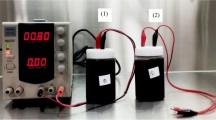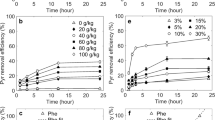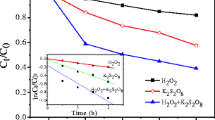Abstract
This work aims to evaluate the efficiency of the degradation of BTX in soil contaminated with oil effluent by chemical oxidation using hydrogen peroxide and potassium permanganate. The initial concentration of BTX in soil was: benzene, 41.4 μg kg−1; toluene, 30.9 μg kg−1; xylene, 1,522.7 μg kg−1 and in water was: benzene, 18.6 μg mL−1; toluene, 18.0 μg mL−1; xylene, 565.8 μg mL−1. The results showed an elevated efficiency in the degradation of BTX by using these compounds, removing 95.2%, 93.5%, and 95.5% of benzene, toluene, and xylene, respectively, with a solution of hydrogen peroxide and 89.3%, and 94.4% of toluene and xylene, respectively, with a solution of potassium permanganate at 4.5%. Benzene was not degraded in potassium permanganate solution.

Similar content being viewed by others
References
Botalova, O., Schwarzbauer, J., Frauenrath, T., & Dsikowitzky, L. (2009). Identification and chemical characterization of specific organic constituents of petrochemical effluents. Water Research, 43(15), 3797–3812.
Brazilian Health Ministry. (2004). Portaria nº 518, de 25 de março de 2004. Brasilia: Ministry of the Health.
Brown, G. S., Barton, L. L., & Thomson, B. M. (2003). Permanganate oxidation of sorbed polycyclic aromatic hydrocarbons. Waste Management, 23, 737–740.
Casarini, I., Pinatti, D. C., Dias, C. L., & Lemos, M. M. G. (2001). Report of establishment of orienting values for ground and underground waters in the state of São Paulo. (pp. 75–182): CETESB.
CETESB (2001). Manual management of contaminated areas. Company of Technology of Ambient Sanitation (2 ed., pp. 389): CETESB.
Chen, G., Hoag, G. E., Chedda, P., Nadim, F., Woody, B. A., & Dobbs, G. M. (2001). The mechanism and applicability of in situ oxidation of trichloroethylene with Fenton's reagent. Journal of Hazardous Materials, 87(1–3), 171–186.
Dua, M., Singh, A., Sethunathan, N., & Johri, A. K. (2002). Biotechnology and bioremediation: successes and limitations. Applied Microbiology and Biotechnology, 59(2–3), 143–152.
Duarte-Davidson, R., Courage, C., Rushton, L., & Levy, L. (2001). Benzene in the environment: an assessment of the potential risks to the health of the population. Occupational and Environmental Medicine, 58(1), 2–13.
Farhadian, M., Duchez, D., Vachelard, C., & Larroche, C. (2008). Monoaromatics removal from polluted water through bioreactors—A review. Water Research, 42(6–7), 1325–1341.
Ferrarese, E., Andreottola, G., & Oprea, I. A. (2008). Remediation of PAH-contaminated sediments by chemical oxidation. Journal of Hazardous Materials, 152(1), 128–139.
Fichet, G., Comoy, E., Dehen, C., Challier, L., Antloga, K., Deslys, J. P., et al. (2007). Investigations of a prion infectivity assay to evaluate methods of decontamination. Journal of Microbiological Methods, 70(3), 511–518.
Gejlsbjerg, B., Andersen, T., & Madsen, T. (2004). Mineralization of organic contaminants under aerobic and anaerobic conditions in sludge–soil mixtures. Journal of Soils and Sediments, 4(1), 30–36.
Guerin, T. F. (2008). Environmental liability and life-cycle management of used lubricating oils. Journal of Hazardous Materials, 160(2–3), 256–264.
Heiderscheidt, J. L., Siegrist, R. L., & Illangasekare, T. H. (2008). Intermediate-scale 2D experimental investigation of in situ chemical oxidation using potassium permanganate for remediation of complex dnapl source zones. Journal of Contaminant Hydrology, 102(1–2), 3–16.
Houk, V. S. (1992). The genotoxicity of industrial wastes and effluents. Mutation Research, 277(2), 91–138.
Interstate Technology Regulatory Council (ITRC). (2005). Technical and regulatory guidance for in situ chemical oxidation of contaminated soil and groundwater (2nd ed.). Washington: ITRC, ISCO Team.
Khaitan, S., Kalainesan, S., Erickson, L. E., Kulakow, P., Martin, S., Karthikeyan, R., et al. (2006). Remediation of sites contaminated by oil refinery operations. Environmental Progress, 25(1), 20–31.
Kong, S.-H., Watts, R. J., & Choi, J.-H. (1998). Treatment of petroleum-contaminated soils using iron mineral catalyzed hydrogen peroxide. Chemosphere, 37(8), 1473–1482.
Lindsey, M. E., & Tarr, M. A. (2000). Quantitation of hydroxyl radical during Fenton oxidation following a single addition of iron and peroxide. Chemosphere, 41(3), 409–417.
Lipczynska-Kochany, E., Sprah, G., & Harms, S. (1995). Influence of some groundwater and surface waters constituents on the degradation of 4-chlorophenol by the fenton reaction. Chemosphere, 30(1), 9–20.
Lobachev, V. L., Radakov, E. S., & Zaichuk, E. V. (1997). Kinetics, isotope effects, and substrate selectivity of alkylbenzene oxidation in aqueous permanganate solutions: VI. Reaction with MnO −3 . Kinetics and Catalysis, 38, 745–761.
Lopez, E., Schuhmacher, M., & Domingo, J. L. (2008). Human health risks of petroleum-contaminated groundwater. Environmental Science and Pollution Research, 15(3), 278–288.
Mysore, D., Viraraghavan, T., & Jin, Y. C. (2006). Oil/water separation technology—A review. Journal of Residuals Science & Technology, 3(1), 5–14.
Nadim, F., Hoag, G. E., Liu, S. L., Carley, R. J., & Zack, P. (2000). Detection and remediation of soil and aquifer systems contaminated with petroleum products: An overview. Journal of Petroleum Science and Engineering, 26(1–4), 169–178.
Niven, K., & McLeod, R. (2009). Offshore industry: management of health hazards in the upstream petroleum industry. Occupational Medicine-Oxford, 59(5), 304–309.
Pignatello, J. J., Oliveros, E., & MacKay, A. (2006). Advanced oxidation processes for organic contaminant destruction based on the Fenton reaction and related chemistry. Environmental Science & Technology, 36, 1–84.
Poggio, L., & Vrscaj, B. (2009). A gis-based human health risk assessment for urban green space planning—An example from Grugliasco (Italy). The Science of the Total Environment, 407(23), 5961–5970.
Ravikumar, J. X., & Gurol, M. D. (2002). Chemical oxidation of chlorinated organics by hydrogen peroxide in the presence of sand. Environmental Science & Technology, 28(3), 394–400.
Rivas, F. J. (2006). Polycyclic aromatic hydrocarbons sorbed on soils: a short review of chemical oxidation-based treatments. Journal of Hazardous Materials, 138(2), 234–251.
Rodrigues, S. M., Pereira, M. E., da Silva, E. F., Hursthouse, A. S., & Duarte, A. C. (2009). A review of regulatory decisions for environmental protection: part II—The case study of contaminated land management in Portugal. Environment International, 35(1), 214–225.
Roes, A. L., & Patel, M. K. (2007). Life cycle risks for human health: A comparison of petroleum versus bio-based production of five bulk organic chemicals. Risk Analysis, 27(5), 1311–1321.
Romero, A., Santos, A., Vicente, F., Rodriguez, S., & Lafuente, A. L. (2009). In situ oxidation remediation technologies: Kinetic of hydrogen peroxide decomposition on soil organic matter. Journal of Hazardous Materials, 170(2–3), 627–632.
Tiburtius, E. R. L., Peralta-Zamora, P., & Leal, E. S. (2004). Contamination of waters by BTXs and processes used in the remediation of contaminated sites. Quimica Nova, 27(3), 441–446.
Veil, J. A. (2003). Innovative technologies for managing oil field waste. Journal of Energy Resources Technology-Transactions of the Asme, 125(3), 238–248.
Villa, R. D., Trovó, A. G., & Nogueira, R. F. P. (2008). Environmental implications of soil remediation using the Fenton process. Chemosphere, 71(1), 43–50.
Watts, R. J., Stanton, P. C., Howsawkeng, J., & Teel, A. L. (2002). Mineralization of a sorbed polycyclic aromatic hydrocarbon in two soils using catalyzed hydrogen peroxide. Water Research, 36(17), 4283–4292.
Yang, C., Xu, Y. R., Teo, K. C., Goh, N. K., Chia, L. S., & Xie, R. J. (2005). Destruction of organic pollutants in reusable wastewater using advanced oxidation technology. Chemosphere, 59(3), 441–445.
Zeyaullah, M., Atif, M., Islam, B., Abdelkafe, A. S., Sultan, P., ElSaady, M. A., et al. (2009). Bioremediation: A tool for environmental cleaning. African Journal of Microbiology Research, 3(6), 310–314.
Acknowledgments
The authors would like to thank the Post-Graduate Program of the Regional University of the Blumenau for financial support for this research.
Author information
Authors and Affiliations
Corresponding author
Rights and permissions
About this article
Cite this article
Rinaldi, A., Da Silva, M.R. Degradation of BTX in Contaminated Soil by Using Hydrogen Peroxide (H2O2) and Potassium Permanganate (KMnO4). Water Air Soil Pollut 217, 245–254 (2011). https://doi.org/10.1007/s11270-010-0583-x
Received:
Accepted:
Published:
Issue Date:
DOI: https://doi.org/10.1007/s11270-010-0583-x




